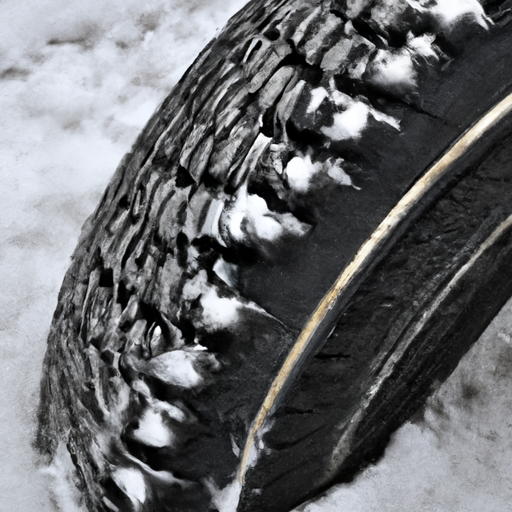If you’ve ever found yourself slipping and sliding on icy roads during the winter, you might have wondered if there’s a better solution to staying safe on the streets. Well, you’re in luck because we’re here to talk about winter tires and their potential to improve traction on those treacherous icy surfaces. So, if you’re curious to find out whether winter tires are worth the investment, stick around and we’ll help shed some light on the subject.

How do winter tires work?
Winter tires are specially designed to provide better traction and grip on icy and snowy roads. They achieve this through several key features:
Rubber compound
The rubber used in winter tires is softer and more flexible than that of regular tires. This allows the tire to conform to the road surface and provides better grip, even in freezing temperatures.
Tread design
Winter tires have deeper and more aggressive tread patterns compared to regular tires. These unique tread designs are specifically designed to channel snow and water away from the tire’s contact patch, allowing for maximum road contact and improved traction.
Sipes
Sipes are tiny slits or channels in the tread blocks of winter tires. These provide additional biting edges for increased traction on icy and slippery surfaces. Sipes enhance grip by allowing the tread blocks to flex and conform to the road, providing better grip and stability.
Studding
Some winter tires feature metal studs embedded in the tread. These studs further enhance traction by biting into icy surfaces, offering improved grip and stability. However, studded tires are not legal in all areas and may cause damage to road surfaces, so it’s important to check local regulations before using them.
What are the benefits of using winter tires on icy roads?
Using winter tires on icy roads provides numerous benefits that can greatly enhance your safety and control while driving:
Better grip on ice
Winter tires are specifically designed to provide maximum grip on icy surfaces. Their unique rubber compound and tread design allow them to maintain better traction, reducing the risk of skidding or sliding.
Shorter braking distance
Winter tires offer improved braking performance on icy roads. The increased traction and grip allow for shorter braking distances, giving you more control and reducing the risk of accidents.
Enhanced stability and control
With winter tires, you’ll experience greater stability and control on icy roads. The advanced tread designs and specialized rubber compound work together to ensure your vehicle stays planted, reducing the chances of losing control.
Improved cornering ability
Winter tires provide better cornering performance on icy roads. The improved grip and traction allow for more precise steering and safer maneuverability, ensuring you can navigate turns with confidence.
Reduced risk of hydroplaning
Winter tires effectively channel snow, slush, and water away from the tire’s contact patch, reducing the risk of hydroplaning. This helps maintain better control and stability, even in wet and icy conditions.
Are winter tires necessary for driving on icy roads?
While winter tires are not legally required in all areas, they are highly recommended, especially if you frequently drive on icy roads. Here are two important factors to consider:
Legal requirements
Some regions have laws mandating the use of winter tires during specific months or in certain weather conditions. It’s vital to familiarize yourself with the regulations in your area and ensure compliance for both your safety and legal peace of mind.
Safety considerations
Even where not legally required, using winter tires on icy roads is strongly advised for optimal safety. The improved traction and grip they offer can significantly reduce the risk of accidents and provide greater control over your vehicle.
When should winter tires be installed?
Knowing when to install your winter tires is crucial to ensure optimal performance and safety. Two factors come into play:
Temperature guidelines
Winter tires are best suited for temperatures below 7°C (45°F). As the temperature drops, regular tires start to lose their flexibility, reducing traction. Installing winter tires before the temperature consistently stays below this threshold is recommended.
Seasonal changeover
It’s advisable to install winter tires before the first significant snowfall or when you anticipate encountering icy road conditions. Depending on your location, this may vary, so it’s important to stay informed about weather patterns in your area.

How to choose the right winter tires?
Selecting the right winter tires involves considering several factors to ensure optimal performance and safety:
Tire size and type
It’s crucial to choose winter tires that are the correct size for your vehicle. Refer to your vehicle’s manual or consult a tire professional to determine the appropriate tire size and type, considering factors such as rim diameter and overall tire dimensions.
Speed and load rating
Ensure that the winter tires you choose have a suitable speed and load rating. These ratings indicate the maximum speed and weight load the tires can handle, ensuring they are suitable for your specific vehicle.
Labels and certification
Look for winter tires that have certification from reputable testing organizations, such as the Rubber Manufacturers Association (RMA) or the Rubber Association of Canada (RAC). These certifications indicate that the tires meet specific quality and performance standards.
Special features
Consider any special features that may be beneficial for your driving conditions. Some winter tires have additional features such as enhanced ice traction or improved performance on wet roads. Assess your driving needs and choose tires that best meet those requirements.
How to maintain and store winter tires?
Proper maintenance and storage of winter tires can help extend their lifespan and ensure optimal performance season after season. Here are a few essential tips:
Tire pressure and rotation
Regularly check and maintain the appropriate tire pressure for your winter tires. Improper tire pressure can negatively affect performance and safety. Additionally, consider rotating your tires regularly to promote even wear and maximize their longevity.
Tread depth inspection
Monitor the tread depth of your winter tires regularly. Adequate tread depth is critical for optimal traction and grip on icy roads. If the tread depth falls below the recommended level, it may be time to replace your winter tires.
Storage tips
When not in use, store your winter tires in a cool, dry, and clean location away from direct sunlight. Properly cleaning and drying the tires before storage is important to prevent any moisture-related damage. Consider using tire bags or covers to protect them from dust and debris.

Tips for driving with winter tires on icy roads
Even with winter tires, it’s essential to adjust your driving habits to ensure optimal safety on icy roads. Here are some helpful tips:
Reduce speed
When driving on icy roads, slow down and maintain a safe speed that allows for better control and reaction time. Remember, winter tires provide improved grip, but they are not invincible.
Increase following distance
Leave ample space between your vehicle and the one ahead of you. This increased distance allows for greater reaction time and reduces the risk of accidents or collisions, especially when braking.
Avoid sudden maneuvers
Driving smoothly and avoiding abrupt movements can help maintain stability on icy roads. Sudden acceleration, braking, or steering maneuvers can cause your vehicle to lose traction and potentially lead to a loss of control.
Proper braking technique
Use gentle and gradual braking techniques on icy roads to prevent skidding or sliding. Apply steady pressure to the brake pedal and allow sufficient time for your vehicle to come to a complete stop.
Common misconceptions about winter tires
There are several misconceptions surrounding winter tires that need clarification:
All-season tires vs. winter tires
While all-season tires offer a compromise between different weather conditions, they do not provide the same level of traction and performance as dedicated winter tires on icy roads. Winter tires are specifically designed to excel in cold temperatures and slippery conditions.
Front-wheel drive and winter tires
While front-wheel drive vehicles generally display better traction on icy roads, this does not negate the need for winter tires. All vehicles, regardless of their drivetrain configuration, can benefit from the improved grip and traction provided by winter tires.
Winter tires vs. tire chains
Tire chains are another option for improving traction on icy roads. However, chains are typically more cumbersome to install and remove, and they can damage the road surface. Winter tires offer a simpler and more convenient solution for enhanced traction without the downsides of chains.

Cost considerations of winter tires
While winter tires do require an initial investment, the long-term savings and increased safety they provide outweigh the costs:
Initial investment
Winter tires can be more expensive than regular tires due to their specialized design and materials. However, the improved performance and durability they offer make them a worthwhile investment.
Long-term savings
Using winter tires can extend the lifespan of your regular tires, as they are not subjected to harsh winter conditions. Additionally, the improved safety and reduced risk of accidents can help you avoid costly repairs and insurance claims.
Conclusion
Winter tires are a valuable tool for safe driving on icy roads. With their specialized features and design, they offer better traction, shorter braking distances, enhanced stability, improved cornering ability, and reduced risk of hydroplaning. While not legally required in all areas, the safety benefits of using winter tires are undeniable. By understanding how winter tires work, knowing when to install them, selecting the right tires for your vehicle, and following proper maintenance and driving techniques, you can maximize the performance and safety they offer. So don’t let icy roads get in your way – equip yourself with winter tires and enjoy confident and secure driving all winter long.


